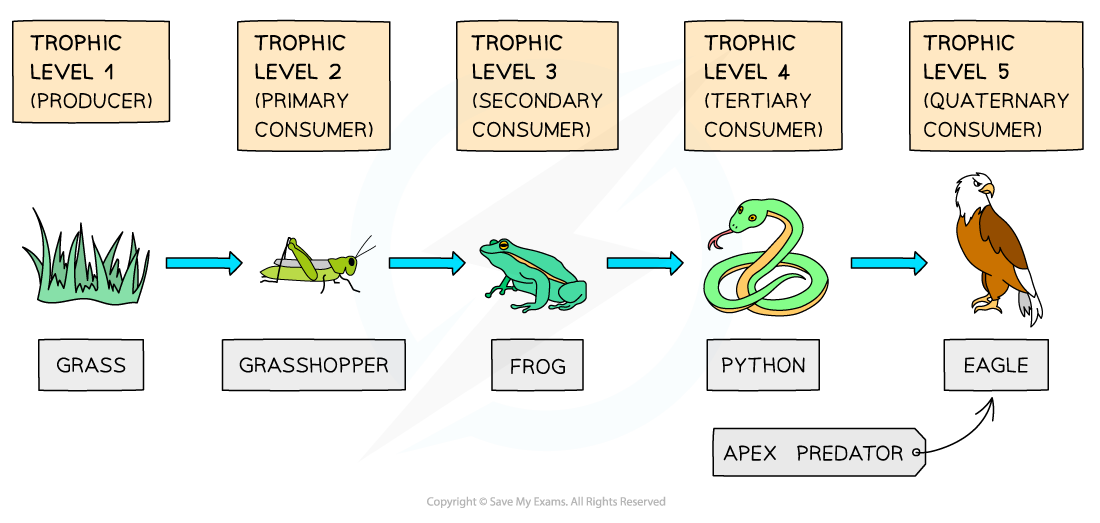Initial Source of Energy
- The sun is the initial (first) source of energy for most food chains
- Light energy from the sun is converted by producers into chemical energy stored in the tissues of plants during the process of photosynthesis
- Chemical energy stored in the tissues of plants passes to primary consumers when they ingest plants, and on to secondary consumers when the primary consumers are themselves ingested
- There are a few unusual exceptions, such as food chains located in deep sea volcanic vents that rely on bacteria gaining energy from chemical processes; these are chemoautotrophic bacteria
Light Energy Conversion
- Photosynthesis is the process of converting light energy into chemical energy
- The photosynthetic pigment chlorophyll absorbs light energy when sunlight lands on photosynthesising parts of a plant
- This light energy is used to power several processes which result in the production of organic molecules, or carbon compounds, including:
- Glucose, which is used in respiration or stored in plant cells in the form of starch
- Lipids
- Amino acids
- Hydrolysing these carbon compounds releases energy, so they can be said to contain stored chemical energy
- These carbon compounds are used by the plant to build plant tissues, meaning that the energy stored in them is stored within the tissues of the plant
Energy Flow Through Food Chains
- Chemical energy, stored in carbon compounds in plant tissues, is passed to the primary consumer when the plant is ingested
- The primary consumer digests the plant tissues and absorbs the carbon compounds containing stored chemical energy
- These carbon compounds can either be used to fuel respiration or to build up animal tissue, meaning that the stored chemical energy is transferred to the tissues of the primary consumer
- When the primary consumer is ingested, the carbon compounds in its tissues, along with their stored chemical energy, pass to the secondary consumer, and so on up the food chain
- When an organism dies, the chemical energy stored in carbon compounds in its tissues passes to detritivores and saprotrophs
- In a food chain, the arrows represent the transfer of energy, in the form of stored chemical energy in carbon compounds, from one trophic level to the next, by the process of feeding

A simple food chain - the blue arrows show how the chemical energy originally stored by the producer is transferred to other organisms in the food chain
Exam Tip
Don't forget that the arrows in a food chain or food web represent the transfer of chemical energy from one trophic level to the next through feeding.
Energy Lost by Respiration
- The chemical energy stored in ingested carbon compounds can be released by the process of respiration
- The carbon compound glucose is the fuel for respiration
- Other carbon compounds such as lipids can be converted into glucose before being respired
- The energy released during respiration can be used by organisms to carry out the functions of life
- Metabolism - the enzyme-catalysed reactions taking place inside cells
- Reproduction - the sexual or asexual production of offspring
- Homeostasis - the maintenance of internal conditions within tolerable limits
- Growth - increasing in size
- Note that during growth some of the chemical energy in the carbon compounds ingested by an organism is incorporated into the tissues of the organism as it grows; this stored chemical energy can be passed to the next trophic level in the food chain
- Response - sensing and responding to the environment
- Excretion - disposal of metabolic waste
- Nutrition - gaining energy and nutrients
- The process of respiration also releases heat as a by-product
Energy Conversions
- The process of respiration in living organisms releases heat as a by-product
- This applies in producers, consumers, detritivores, and saprotrophs
- Living organisms cannot convert the heat energy that is released as a by-product of respiration into any other form of energy
- This means that heat energy is lost from food chains at every trophic level, as well as during decomposition
- This heat energy is ultimately lost to the environment
- Ecosystems have enough energy to be sustainable because energy is always entering food chains via producers as they capture light energy from the sun
Exam Tip
Be careful with your language when discussing energy. You should always describe energy as being released, stored, converted (from one form to another), or transferred (e.g. lost to the environment), never as being produced, made, or destroyed.
